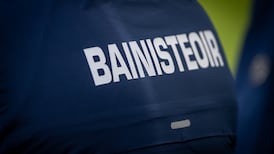The casual utterance of sweeping assertions has always held a special place within the GAA – damning verdicts like “the worst centre forward in Europe” – and there’s a fair head of steam building up behind the idea that the current championship is particularly bad across the codes.
Systemic failings, systematic beatings, ultra-defence, immoveable elites and, of course, shockingly dismal weather all feed into a sense of malaise. For some people it would be good to go back to the old days before the qualifiers artificially extended the agony of inadequate championship structures.
Now retired Leinster CEO Michael Delaney resolutely held the view that the qualifiers had become the primary problem in the GAA's perennial club fixtures crisis.
Delaney’s thoughtful but stark arguments made sense in that they categorised intercounty activity in a certain and very traditional way. There has been a development – evolution depending on your point of view – that has taken intercounty competition from the realms of occasional, representative sport to the current status of the association’s dominant business.
For all the legitimate finger-wagging about clubs being responsible for 98 per cent of GAA activity, the remaining 2 per cent is box office and funds the association. In the past county teams had their fixtures spread so thinly around the year that they caused virtually no disruption: league campaigns that straggled aimlessly from October to May, averaging a match a month, gave way to championship seasons that were over for half the counties after a couple of weeks.
Coherent schedule
By compacting the competitive calendar into a coherent schedule and facilitating more sustained involvement, the GAA has created a conventional season, which makes serious demands on all counties. The problem is that not all counties are serious.
Throughout history these counties have been happy enough to fulfil league matches, take their beating in May and go back to whatever they do. The advent of the new season structure at the turn of the century has meant teams have to be in training during the spring to cope with the fixtures onslaught and are required to stay around in the summer until at least the end of June.
Not everyone wants to do that. How many times do we learn of players turning their back on county teams and heading to the US rather than give the qualifiers their best shot? Supporters are frequently as disinterested. Why for instance will the attendance at a provincial championship match (say, Westmeath-Louth in 2012) be twice what the exact same pairing can attract to a qualifier, which is sudden death and after which one of the team’s seasons will be over?
This year has seen a great deal of existential angst about the nature of the football championship and a fair few proposals – some interesting and others a bit parallel universe-y – for alternative structures.
The overriding problem with the current competition is that it enshrines the inequality of resources inherent in the counties in terms of population and commercial potential.
The only way of ameliorating this reality is either to grade the competitions or handicap them. The latter is plainly impractical in field sports and the former is of no interest to the counties for whatever reason. Why was the well intentioned Tommy Murphy Cup so unloved that it was discontinued when previous incarnations of "B" All-Irelands were quite popular?
I remember two women coming up to the late Bobby Miller on the field in Tullamore after he had managed Carlow to the 1994 All-Ireland "B" football title. "Congratulations. We don't know you but we're followers," was the vaguely devotional message.
Big deal
More strikingly, a crowd of 8,000 had turned up to see the final against Westmeath. It was a big deal. Significantly, though, it wasn’t played through the summer as an alternative to the championship but as a winter diversion.
Everything in its place in other words. I originally thought that the hurling championship was made for a league format: a limited number of counties, who could all play each other. It actually works but only in the league and during the spring.
Try the round-robin structure during the summer and no-one's interested. Cork and Tipperary packed out the Munster finals of 2005 and 2006 in Páirc Uí Chaoimh and Semple Stadium. A year later they found themselves in one of the qualifier groups and 12,833 turned up on a lovely, sunny July evening.
The GAA membership like things largely the way they’ve always been and if that means occasional thrashings, so be it. There may be disparity of resources but we’re talking about sports where 60 per cent of all senior All-Ireland titles have gone to five counties.
There were never equal opportunities activities.
The miracle of the past 15 years is that somehow a system has been found to stretch the competitive schedules a little bit in order to give more counties a day out and the association more events to promote while at the same time still keeping people interested. Had Monaghan won at the weekend, the All-Ireland semi-final line-up would have been exactly the same as 30 years ago but we sometimes forget what non-events football semi-finals frequently were.
Back in 1985, Monaghan and Kerry played out an exciting draw. The public hadn’t been expecting it and the match attendance of 21,746 was in line with the interest in semi-finals that didn’t pair the Munster and Leinster champions, as happened every three years.
In the past fortnight more than 120,000 turned up for the two All-Ireland quarter-final double bills – events that didn’t exist 15 years ago.
So is the current season particularly disappointing? I’ve lived through worse.
smoran@irishtimes.com












